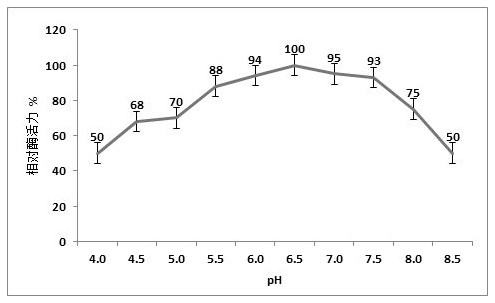Bacillus subtilis for producing D-psicose as well as culture method and application thereof
A technology of Bacillus subtilis and psicose, which is applied in the field of Bacillus subtilis for producing D-psicose and its cultivation, can solve the problems of poor conversion ability, improve efficiency, reduce production cost, and adapt to the range of pH wide effect
- Summary
- Abstract
- Description
- Claims
- Application Information
AI Technical Summary
Problems solved by technology
Method used
Image
Examples
Embodiment 1
[0032] Isolation and identification of strains
[0033] Plate culture medium: composed of the following components by weight percentage, 1% tryptone, 0.5% yeast extract powder, 1% sodium chloride, 2% agar powder, and the balance deionized water.
[0034] Slant culture medium: composed of the following components in weight percentage, 1% tryptone, 0.5% yeast extract powder, 1% sodium chloride, 2% agar powder, and the balance deionized water;
[0035] Shake flask culture medium: composed of the following components by weight percentage, peptone 2.5%, corn steep liquor powder 1%, glycerin 1%, anhydrous magnesium sulfate 0.05%, disodium hydrogen phosphate 0.05%, sodium dihydrogen phosphate 0.4%, the balance For deionized water, pH6.8;
[0036] (1) Strain source and screening
[0037] Select the soil near the special sugar workshop of Shandong Baolingbao Biological Co., Ltd., remove the topsoil with a shovel, take about 10g of the soil 10-15cm above the ground, and put it into a ...
Embodiment 2
[0045] Seed culture medium: composed of the following components by weight percentage, peptone 1%, yeast extract powder 0.5%, sodium chloride 1%, balance water, pH6.8;
[0046] Fermentation medium: composed of the following components by weight percentage, peptone 2.5%, corn steep liquor powder 1%, glycerin 1%, anhydrous magnesium sulfate 0.05%, disodium hydrogen phosphate 0.05%, sodium dihydrogen phosphate 0.4%, and the balance is Deionized water, pH6.8;
[0047] (1) Take Bacillus subtilis ( Bacillus subtilis ) blb-12-B, inoculated in the seed medium, and cultured for 10 hours at 37°C to obtain the seed solution;
[0048] (2) Take the seed solution prepared in step (1), inoculate it in the fermentation medium at a ratio of 5% by volume, ferment and cultivate it at 33° C., continuously replenish the fermentation medium during the fermentation process, and ferment for 52 hours to obtain Bacterial fermentation broth, centrifuged to obtain D-psicose 3-epimerase cells, then reco...
Embodiment 3
[0050] The effect of pH on the stability of enzyme activity:
[0051] For the D-psicose 3-epimerase serum obtained in Example 2, its enzyme activity at different pHs was tested to investigate the optimum pH of the enzyme. The reaction temperature was controlled at 55°C, respectively at pH4. The buffer solution of 0-8.5 configures the substrate to measure the enzyme activity, and the result is as follows figure 1 shown by figure 1 It can be seen that when the pH is between 5.5-7.5, the relative enzyme activity remains above 85%, when the pH value is between 5.0-8.0, the relative enzyme activity remains above 70%, and the enzyme activity is the highest at pH 6.5 , reaching 680U / ml.
PUM
 Login to View More
Login to View More Abstract
Description
Claims
Application Information
 Login to View More
Login to View More - R&D
- Intellectual Property
- Life Sciences
- Materials
- Tech Scout
- Unparalleled Data Quality
- Higher Quality Content
- 60% Fewer Hallucinations
Browse by: Latest US Patents, China's latest patents, Technical Efficacy Thesaurus, Application Domain, Technology Topic, Popular Technical Reports.
© 2025 PatSnap. All rights reserved.Legal|Privacy policy|Modern Slavery Act Transparency Statement|Sitemap|About US| Contact US: help@patsnap.com

